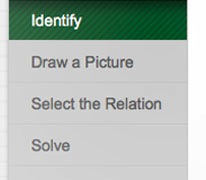Modern Physics Problems
Two areas of modern physics are addressed through example problems on this page. Special Relativity problems ask you to relate the observations of two observers measuring the same thing. In Quantum Mechanics problems, you may look at wave or particle behavior of light and subatomic particles. As always, basic definitions problems are found with other Definitions examples.
Example Problems
-
Relativity
-
Foundations of Quantum Mechanics
How to Solve Special Relativity Problems
-
1.Identify the Problem

Any problem that asks you to relate the observations made by two observers measuring the same thing is a relativity problem. Note that sometimes one of the observers is implied—for example, if you are asked for length of a something “in the frame of the electron” there is an implied observer in the same reference frame as the electron.
-
2. Draw a Picture
In Special Relativity problems, you relate the observations made by two observers in different reference frames measuring the same thing. Therefore, useful pictures are pictures of the motion being described with the two observers and the experiment (the thing that they are measuring) clearly indicated. The relative velocity of the two observers should also be shown. If the observers are measuring length or a time interval, one of the frames is the proper frame and should be identified as such. If the observers are measuring velocity, your mathematical solution will be easier if you choose the ‘ frame to be that of the observer whose velocity measurement you already know.
-
3. Select the Relation
There are three key relations for Special Relativity. The correct relation to understand a situation is based on what the observers are measuring.
If the two observers are measuring the length of something, their measurements are related by

When two observers time the same event, their measurements are related by

When two observers measure the velocity of a third object, their measurements are related by

Note that the symbol v in all three equations refers to the relative velocity between the two observers (reference frames.) In the case of the third equation, make sure to assign v the sign to correctly represent the direction of the ‘ observer’s motion according to the other observer.
-
4. Solve the Problem
If your picture clearly shows your choice of frames, the experiment, and the relative motion between frames, solving the problem is merely a matter of filling values from the picture into the equation and doing algebra.
Note that for the velocity equation you need to consider the sign of u, u’, and v. Sign is given by the direction of the velocity. Note that v is the velocity of the observer in the ‘ frame as measured by the other observer.

-
5. Understand the Results
Once you have completed the problem, look at it again. Does your answer make sense? Did it give the behavior you intuitively expected to find? (Remember, you expect objects moving relative to you to be shorter, and events in frames moving relative to you to take longer. Relative velocities should never be greater than c, and objects approaching each other should have a higher relative velocity than either of their speeds relative to some other point.) If your numerical answers do not make sense, the most common errors are incorrect choice for proper frame or incorrect sign of v in the velocity equation. Can you now do steps that caused you problems earlier? Can you explain in words what is happening?
Help! I can’t find an example that looks like the problem I need to work!
-
Are you certain your problem is a Modern Physics problem?
One of the most common mistakes is to think too hard. Many of the problems that you will encounter in an introduction to quantum mechanics are definition problems—for example, examining the closely related quantities of wavelength and photon energy. Check Definition and Ratio problems to see if you can find a useful example.
-
Yes, my problem is definitely a Modern Physics problem.
In that case, think more broadly about what makes a useful example. Remember, you were given your assignment to practice the problem solving approach, not because the answers to your problems are particularly interesting. An example in which you merely substitute your numbers for those in the problem will give you practice entering numbers on your calculator but will teach you nothing about physics, and when you take your exam every problem on it will feel new and different to you. So think about your example as support for helping you to practice the problem solving approach.
In particular, if two problems address the same key physics they will be addressed in the same way regardless of what quantity you are asked to find. If two observers measure the length of some object, for example, the problem is approached in an identical way regardless of whether you want to know the length measured by observer 1, the length measured by observer 2, or the relative velocity between them.
That said, there are many different areas of modern physics and many subtopics within those areas. You will not find examples of topics such as cosmology or material science on this page.
